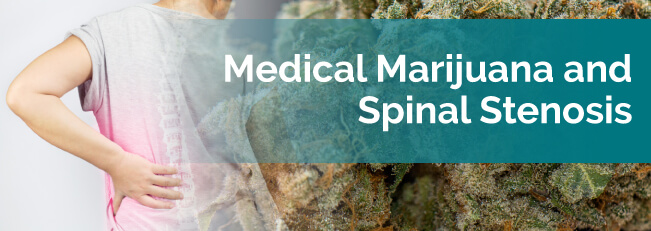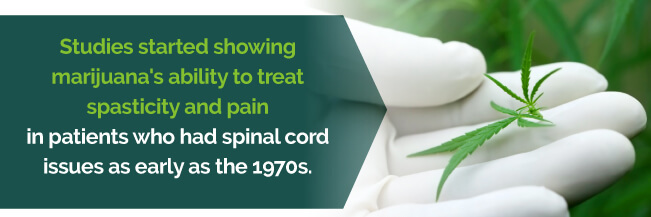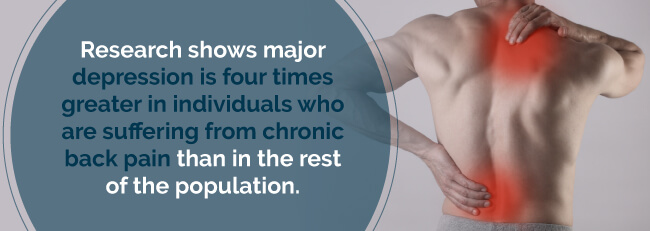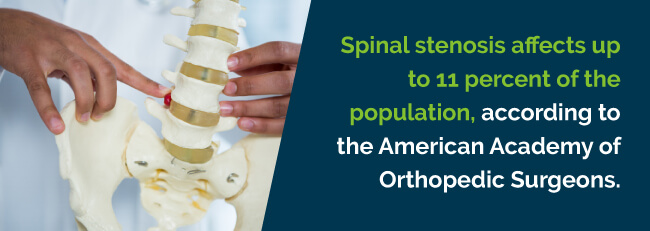
Medical marijuana is rapidly coming on the scene as an excellent therapeutic agent, thanks to a host of positive research studies and legislation approving it for use for an increasing number of qualifying medical conditions. And while this amazing herb can help treat temporary conditions, like nausea, migraines, and insomnia, you can now find relief for more severe, long-term diseases, such as medical marijuana for spinal stenosis and the chronic pain associated with it.
Medical marijuana is proving to be a safer, healthier option for chronic pain in some sufferers. Like all pain medications, its efficacy depends on individual tolerance and the presence of harmful side effects. Nonetheless, it’s working well for most individuals in clinical and pre-clinical trials. It is proving to be a reliever of nerve pain, which is precisely what spinal stenosis sufferers need.
Find A Doctor Find A Dispensary
A study at the University of California, San Francisco, showed medical marijuana is a viable medication for use with opiates in chronic pain. When used with opiates, it decreases the amount of addictive and potentially dangerous opiates a patient needs to ingest. Marijuana has never been shown to produce life-threatening overdose symptoms, so it is a much safer alternative to large doses of opiate medication as a patient builds up a tolerance for the drugs.
In the UCSF study, patients who received medical marijuana, along with a lower dose of their opiates, did not lose their pain relief. In fact, they obtained more pain relief from the combination than they were getting from their opiate regimens.
Because opiate use can result in death if patients do not use the drugs responsibly, reducing opiate dosages by combining them or replacing them with marijuana could potentially save lives. Patients get more pain relief and less risk of death. Medical marijuana can also help with pain after surgical treatment of spinal stenosis.
Studies conducted in the past 20 years have shown without a doubt medical marijuana can alleviate stiffness in the muscles caused by multiple sclerosis, symptoms of peripheral neuropathy, symptoms of compression neuropathy, symptoms of sensory neuropathy in AIDS patients and more. These symptoms include pain, tingling, burning, and weakness.
Spinal stenosis causes neuropathy, so these studies into conditions like multiple sclerosis and AIDS show medical marijuana can help patients with spinal stenosis, as well as patients with a range of other nerve-related conditions.
In December 2014, PLoS One published a controlled animal study that showed administering the non-psychoactive cannabinoid cannabidiol (CBD) could be helpful in decreasing the damage intervertebral disc degeneration caused.
Many patients report medical cannabis for spinal stenosis effectively treats their back pain and other related symptoms. In fact, they say medical weed gives them more relief than pharmaceutical medications do for their symptoms, with far fewer side effects.

Cannabis treats back pain effectively due to a couple of its main medicinal ingredients, namely THC and CBD. Both have been well-documented for their anti-inflammatory and pain-relieving properties. Medical marijuana has anti-spasm, anti-anxiety and sedating effects beneficial in treating back pain. Particularly, cannabinoids are useful in treating pain from nerve injuries.
Studies started showing marijuana’s ability to treat spasticity and pain in patients who had spinal cord issues as early as the 1970s. Today, cannabis and spinal stenosis treatment provides patients with an alternative remedy to help fight these unpleasant and relentless symptoms that hurt their quality of life. Certain strains can help with certain symptoms.

For example, take these strains of marijuana for spinal stenosis:
Cannabis topicals for spinal stenosis tend to work well in providing the healing qualities of cannabis and can be a beneficial method for treating your spinal stenosis.
CBD oil plays a role in the treatment for various conditions, including those associated with psychogenic and inflammatory causes. Diseases such as spinal stenosis, which develop because of an ongoing or previous inflammatory reaction, may be improved with CBD oil.
Aside from being a treatment for inflammatory conditions, CBD oil can also battle insomnia and anxiety. And if you have sore muscles along with spinal stenosis, it can help relieve the associated discomfort.
The use of marijuana topicals for spinal stenosis for sciatica improves your symptoms due to its anti-inflammatory characteristics.
When you apply CBD lotion directly to the problem area, you can get topical relief. Balms and lotions containing cannabis bind to your CB2 receptors once your skin absorbs the lotion. Marijuana exhibits its anti-inflammatory and anti-analgesic properties by working with your body’s CB2 receptors.
Other methods of use include ointments and edibles.
If you’re ready to tackle your spinal stenosis with a natural remedy proven to work well, it’s time to give medical marijuana a try. First, you’ll want to check with your state’s laws to make sure medical pot is legal in your state for medicinal purposes and your spinal stenosis symptoms, such as chronic pain. Once you’ve established it is, you can find a medical marijuana doctor or search for a cannabis dispensary.
You’ll find everything you need all in one place here at MarijuanaDoctors.com, and soon could be experiencing the healing effects of this wonder herb yourself. Your doctor will give you a recommendation, and you’ll be able to get your medical marijuana card as soon as possible so you can begin reaping the benefits.
Find A Doctor Find A Dispensary
Spinal stenosis, known medically as degenerative spondylolisthesis, is a common condition that occurs when your spinal canal encasing your spinal cord and nerve roots becomes compressed. When this abnormal narrowing happens, it “pinches” your spinal cord, and often your nerve roots as well, leading to cramping, pain, numbness, and weakness. You might experience these symptoms in your neck, lower back, buttocks, legs, arms or shoulder, depending on where the narrowing occurs.
You’ll usually experience spinal stenosis symptoms gradually, and they worsen over time. You may have severe pain in your legs, making it unbearable to walk even a short distance. To ease the pain, many sufferers have to stay seated or lean forward over something like a countertop. Others resort to strong narcotics or surgery.
Osteoarthritis of your discs between your vertebrae and spinal column typically causes this narrowing. A thickening of your back’s ligaments or bulging of your discs separating the bones of your back can also cause it.
The type of spinal stenosis you have depends on where the condition occurs in your spine.
Some people have both types of lumbar and cervical spinal stenosis. Other spinal stenosis types include foraminal stenosis, central canal stenosis, and far lateral stenosis.
Even though the medical community has recognized spinal stenosis for almost 190 years, disagreement as to its exact definition has made prevalence and incidence studies challenging to interpret.
Spinal stenosis, also referred to as canal stenosis, is more frequent in older patients. We’ve seen an improvement in the diagnosis accuracy, but the number of incidences internationally is increasing. Since surgical treatment can be relatively unpredictable, good knowledge of the predictive factors influencing the disease’s course and natural evolution is vital.
Currently, there aren’t any scientifically based suggestions for patients diagnosed with lumbar degenerative spinal stenosis. Researchers still need to identify predictors of success of surgical and medical treatments, but studies suggest many patients don’t deteriorate automatically and will remain unchanged or improve with medical intervention.
CT and MRI scans often reveal patients have spinal stenosis, even when they’re not experiencing any symptoms. Their signs of the disease, when they do get them, begin slowly and get worse over time. Your symptoms vary, depending on where location of the stenosis and which nerves it affects.
While sitting down can help relieve your symptoms, they’ll return as soon as you begin walking or standing again. Because of its persistent nature, spinal stenosis can wear you down over time.
When you have spinal stenosis, especially in its moderate to severe forms, you can have both physical and mental effects.
The narrow space and thickening in your spinal canal may occur due to your supporting spinal ligaments having degenerative changes. Arthritic changes could enlarge your posterior facet joints. Bulging discs, disc protrusions or herniations can narrow your spinal canal and lead you to experience chronic pain.
If space is narrowed substantially inside your spinal canal because of combined effects from these types of changes, your spinal cord could be at risk. There is a progression of spinal stenosis with constant degenerative changes.
Research shows major depression is four times greater in individuals who are suffering from chronic back pain than in the rest of the population. Studies of depression in patients with chronic low back pain who are going to pain clinics for treatment show an even higher prevalence rate. An average of 62 percent and up to 82 percent of patients with chronic back pain display some form of depressive problem or depression.

If you’re being treated for spinal stenosis and may need back surgery, you should first get an assessment of whether depression is present, and if it could complicate the process.
You should:
There’s a robust, well-established relationship between depression and chronic pain. It can be a problematic cycle until you and your doctor break it with a concurrent and comprehensive strategy of treatment for both your emotional and physical symptoms.
Statistics revolving around spinal stenosis show:

Your treatment depends on where the stenosis is and how severe your symptoms are. Treatments may include the following.
Your physician may prescribe:
When you have spinal stenosis, it’s not uncommon to become less active to try and reduce your pain. However, being inactive can cause weakness in your muscles, resulting in even more pain. Your physical therapist can show you exercises you can do to help:
Your nerve roots may get swollen and irritated at the locations where they are pinched. Steroid injections won’t cure your stenosis, but may help decrease the inflammation and get rid of some of your pain.
Steroid injections don’t work for everybody, and can weaken adjacent connective tissue and bones if repeated often. Therefore, your physician will probably only give you these injections a few times a year.
The doctor uses needle-like instruments during this procedure to remove part of a thickened ligament in your spinal column to provide more canal space and get rid of nerve root impingement. This procedure is only necessary for patients who have a thickened ligament and lumbar spinal stenosis.
If your stenosis isn’t responding to other treatments, or if your symptoms are disabling, your physician may recommend you undergo surgery. With surgery, the surgeon creates more spinal canal space to relieve spinal cord or nerve root pressure.
Your pain management or health care professional may recommend other therapies for your spinal stenosis, including minimally invasive epidural nerve blocks, chiropractic care, massage, biofeedback or neuromodulation.
The current treatments for spinal stenosis are primarily pain management and surgery. Pain management can include counseling, physical therapy and/or pain medications. Medical marijuana cannot replace counseling, physical therapy or surgery if the need for these remedies presents in a person with spinal stenosis.
However, it can replace, complement and/or act as a pain medication for individuals with chronic pain from spinal stenosis. Research also indicates it may help relieve addiction to opiates in individuals who have been prescribed addictive medications for an extended period due to chronic pain.
North Dakota has approved spinal stenosis as a qualifying condition for the use of medical marijuana, and many other states have approved chronic pain for cannabis.